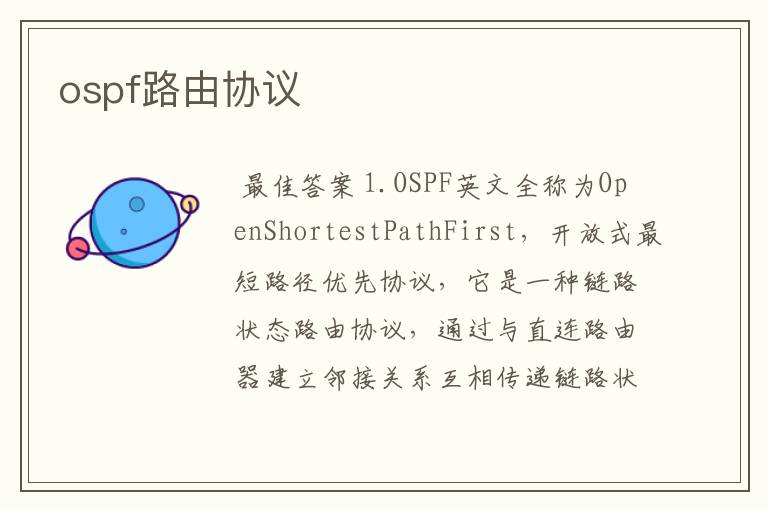ospf英文
今天运困体育就给我们广大朋友来聊聊ospf德甲,希望能帮助到您找到想要的答案。
ospf路由协议

最佳答案1.OSPF英文全称为Open Shortest Path First,开放式最短路径优先协议,它是一种链路状态路由协议,通过与直连路由器建立邻接关系互相传递链路状态信息,来了解整个网络的拓扑结构。就是说,每个运行OSPF进程的路由器都有整个网络的“地图”。
2.运行OSPF进程的路由器都要建立三张表
(1)邻居列表,列出每台路由器全部已经建立邻接关系的邻居路由器
(2)链路状态数据库,列出网络中其他路由器的信息,显示了全网的网络拓扑
(3)路由表,OSPF依据Djkstra算法,从链路状态信息计算得到一个以自己为树根的“最短路径树”,到最后,每台路由器都将从最短路径树中构建自己的路由表(如图)。
3.当整个网络经过链路状态信息的同步收敛,生成路由表后,OSPF在区域内部,就直接转发数据啊,没有什么特别的。
4.一旦设置了多区域,区域间的路由是通过ABR(区域边界路由器)转发的,区域内部的路由器只要知道到ABR的路由就行了,大大减少了内部区域的路由条目。提高了路由器的性能。OSPF的精华就在此。
老大,给分吧,上面我是根据自己的理解一个字一个字打上去的哦!
关于OSPF协议的英文材料,翻译,3000字的
最佳答案请看:
OSPF is an interior gateway protocol that routes Internet Protocol (IP) packets solely within a single routing domain (autonomous system). It gathers link state information from available routers and constructs a topology map of the network. The topology determines the routing table presented to the Internet Layer which makes routing decisions based solely on the destination IP address found in IP datagrams. OSPF was designed to support variable-length subnet masking (VLSM) or Classless Inter-Domain Routing (CIDR) addressing models.
OSPF detects changes in the topology, such as link failures, very quickly and converges on a new loop-free routing structure within seconds. It computes the shortest path tree for each route using a method based on Dijkstra's algorithm, a shortest path first algorithm.
The link-state information is maintained on each router as a link-state database (LSDB) which is a tree-image of the entire network topology. Identical copies of the LSDB are periodically updated through flooding on all OSPF routers.
The OSPF routing policies to construct a route table are governed by link cost factors (external metrics) associated with each routing interface. Cost factors may be the distance of a router (round-trip time), network throughput of a link, or link availability and reliability, expressed as simple unitless numbers. This provides a dynamic process of traffic load balancing between routes of equal cost.
An OSPF network may be structured, or subdivided, into routing areas to simplify administration and optimize traffic and resource utilization. Areas are identified by 32-bit numbers, expressed either simply in decimal, or often in octet-based dot-decimal notation, familiar from IPv4 address notation.
By convention, area 0 (zero) or 0.0.0.0 represents the core or backbone region of an OSPF network. The identifications of other areas may be chosen at will, often, administrators select the IP address of a main router in an area as the area's identification. Each additional area must have a direct or virtual connection to the backbone OSPF area. Such connections are maintained by an interconnecting router, known as area border router (ABR). An ABR maintains separate link state databases for each area it serves and maintains summarized routes for all areas in the network.
OSPF does not use a TCP/IP transport protocol (UDP, TCP), but is encapsulated directly in IP datagrams with protocol number 89. This is in contrast to other routing protocols, such as the Routing Information Protocol (RIP), or the Border Gateway Protocol (BGP). OSPF handles its own error detection and correction functions.
OSPF uses multicast addressing for route flooding on a broadcast network link. For non-broadcast networks special provisions for configuration facilitate neighbor discovery.[1] OSPF multicast IP packets never traverse IP routers, they never travel more than one hop. OSPF reserves the multicast addresses 224.0.0.5 for IPv4 or FF02::5 for IPv6 (all SPF/link state routers, also known as AllSPFRouters) and 224.0.0.6 for IPv4 or FF02::6 for IPv6 (all Designated Routers, AllDRouters), as specified in RFC 2328[3] and RFC 5340[4].
For routing multicast IP traffic, OSPF supports the Multicast Open Shortest Path First protocol (MOSPF) as defined in RFC 1584.[5] Neither Cisco nor Juniper Networks include MOSPF in their OSPF implementations. PIM (Protocol Independent Multicast) in conjunction with OSPF or other IGPs, (Interior Gateway Protocol), is widely deployed.
The OSPF protocol, when running on IPv4, can operate securely between routers, optionally using a variety of authentication methods to allow only trusted routers to participate in routing. OSPFv3, running on IPv6, no longer supports protocol-internal authentication. Instead, it relies on IPv6 protocol security (IPsec).
OSPF version 3 introduces modifications to the IPv4 implementation of the protocol.[2] Except for virtual links, all neighbor exchanges use IPv6 link-local addressing exclusively. The IPv6 protocol runs per link, rather than based on the subnet. All IP prefix information has been removed from the link-state advertisements and from the Hello discovery packet making OSPFv3 essentially protocol-independent. Despite the expanded IP addressing to 128-bits in IPv6, area and router identifications are still based on 32-bit values.
朋友,你可到wikipedia这里进一步搜索.
关于光端机专业名词的中英文及缩写
最佳答案光端机专业名词的中英文及缩写:
ABR Available Bit Rate 可用比特率
ATM Asynchronous Transfer Mode 异步传输模式
CBR Constant Bit Rate 恒定比特率
CS Cross Switch 交叉
DPT Dynamic Packet Transport 动态包传输
EOS Ethernet Over SDH 基于SDH 的以太网
FDDI Fiber Distributed Data Interface 光纤分布数字接口
FDI Forward Defection Indication 前向缺陷指示
FEC Forward Error Correction 前向纠错
FPDC Fiber Passive Dispersion Compensator 光纤无源色散补偿器
GE Gigabit Ethernet 千兆以太网
HDLC High Digital Link Control 高级数据链路控制
IMA Inverse Multiplexing for ATM ATM 的逆复用
IP Internet Protocol Internet (网际) 协议
ISDN Integrated Services Digital Network 综合业务数字网
LAN Local Area Network 局域网
LCAS Link Capacity Adjustment Scheme 链路容量调整方案
MPLS Multiprotocol Label Switching 多协议标签交换
MSTP Multi-Service Transport Network 多业务传送节点
OAM Operation, Administration and Maintenance 运行管理维护
QoS Quality of Service 服务质量
OSI Open System Interconnection 开放系统互联
OSPF Open Shortest Path First 开放最短路径优先(协议)
RPR Resilient Packet Ring 弹性分组(数据)环
rt-VBR Real Time-Variable Bit Rate 实时可变比特率
SDH Synchronous Digital Hierarchy 同步数字体系
SRP Spatial Reuse Protocol 空间重用协议
STM Synchronous Transfer Mode 同步传递(转移)模式
STP Spanning Tree Protocol 生成树协议
UBR Uunspecified Bit Rate 未指定比特率
UNI User Network Interface 用户网络接口
VC Virtual Channel 虚通道
VCC Virtual Channel Connection 虚通道链接
VCI Virtual Channel Identifier 虚通道识别符
VLAN Virtual LAN 虚拟局域网
VOA Variable Optical Attenuator 可调光衰减器
VP Virtual Path 虚通路
VPI Virtual Path Identifier 虚通路识别符
WAN Wide Area Network 广域网
ADM Add-Drop Multiplexer 分插复用器
AIS Alarm Indication Signal 告警指示信号
APS Automatic Protection Switching 自动保护倒换
ATM Asynchronous Transfer Mode 异步转移模式
AU Administrative Unit 管理单元
AU-n Administration Unit,level n N 阶管理单元
AUG Administration Unit Group 管理单元组
AU-PTR Administration Unit Pointer 管理单元指针
BA Booster Amplifier 功率放大器
BBE Background Block Error 背景误块
BBER Background Block Error Ratio 背景块差错比
BER Bit Error Ratio 误比特率
BITS Building Integrated Timing Supply 大楼综合定时供给
BML Business Management Layer 事务管理层
CBR Constent Bit Rate 固定比特率
CDM Code Division Multiplexing 码分复用
CMI Coded Mark Inversion 编码信号反转码
C-n Container- n N 阶容器
CORBA Common Object Request Broker Architecture 公用目标请求掮客结构 CV Code Violation 编码违例
DB Data Base 数据库
DBMS Data Base Management System 数据库管理系统
DCC Data Communications Channel 数据通信通路
DCE Data Circuit-terminating Equipment 数据电路终端设备
DCF Data Communications Function 数据通信功能
DCN Data Communications Network 数据通信网
DDN Digital Data Network 数字数据网
DLL Dynamic Link Libraries 动态链接库
DNA Distributed Network Architecture 分散网络结构
DNI Dual Node Interconnection 双节点互连
DQDB Distributed Queue Double Bus 分布式排队双总线
DTE Data Terminal Equipment 数据终端设备
DWDM Dense Wavelength-division Multiplexing 密集波分复用
DXC Digital Cross Connect 数字交叉连接
ECC Embedded Control Channel 嵌入控制通路
SM-001-C1 SDH 基本原理
EDFA Erbium Doped Fiber Amplifier 掺饵光纤放大器
EM Element Management 网元管理
EMC ElectroMagnetic Compatibility 电磁兼容
EMI ElectroMagnetic Interference 电磁干扰
EML Element Management Layer 网元管理层
EMS Element Management System 网元管理系统
EOS Ethenet Over SDH 基于SDH 网络的以太网
ES Error Second 误码秒
ESD Electronic Static Discharge 静电放电
ESR Error Second Ratio 误码秒比
ETSI European Telecommunication Standards Institute 欧洲电信标准协会
FDM Frequency Division Multiplexing 频分复用
FDDI Fiber Distributed Data Interface 光纤分布式数据接口
FEBBE Far End Background Block Error 远端背景误码块
FEES Far End Errored Second 远端误码秒
FESES Far End Severly Errored Second 远端严重误码秒
GFP Generic Framing Procedure 通用成帧规程
GUI Graphical User Interface 图形用户界面
HDLC High Digital Link Control 高级数据链路控制
HPC Higher order Path Connection 高阶通道连接
HW High-Way 母线
IP Internet Protocol Internet 协议
ITU-T International Telecommunication Union-Telecommunication Standardization Sector 国际电信联盟-电信标准部 L2 Layer 2 OSI 第二层(链路层)
LAN Local Area Network 局域网
LAPD Link Access Procedure On D-channel 通路链路接入规程
LAPS Link Access Procedure for SDH SDH 链路访问规程
LCAS Link Capacity Adjustment Scheme 链路容量调整方案
LCT Local Craft Terminal 本地维护终端
LOF Loss Of Frame 帧丢失
LOP Loss Of Pointer 指针丢失
LOS Loss Of Signal 信号丢失
LPC Lower order Path Connection 低阶通道连接
MAC Medium Access Controll 介质访问控制
MAN Metropolitan Area Network 城域网
MCU Micro Control Unit 微处理器
MD Mediation Device 协调设备
MF Mediation Function 协调功能
MII Medium Independent Interface 独立于介质的接口
MM Multi Mode 多模(光纤)
MS Multiplex Section 复用段
MS-AIS Multiplex Sections - Alarm Indication Signal 复用段告警指示信号
MS-PSC Multiplex Sections - Protection Switching Count 复用段保护倒换计数
MS-PSD Multiplex Sections - Protection Switching Duration 复用段保护倒换间隔 MS-SPRing Multiplexer Section Shared Protection Ring 复用段共享保护环
MSOH Multiplex Section OverHead 复用段开销
MSP Multiplex Section Protection 复用段保护
MSTP Multiple Service Transmite Platform 多业务传送平台
MTIE Maximum Time Interval Error 最大时间间隔误差
NE Network Element 网络单元(网元)
NEF Network Element Function 网络单元(网元)功能
NEL Network Element Layer 网元层
NML Network Manager Layer 网络管理层
NMS Network Management System 网络管理系统
stp和ospf有什么区别
最佳答案stp和ospf区别:
stp是生成树协议,是一个二层的协议;用在一个交换网中规避环路,用STP算法来对冗余的物理拓扑进行闭环。
OSPF是三层的路由协议,是一个开放型的链路状态协议,用来帮助路由器计算到达目的地的最短路径。
STP(Spanning Tree Protocol)是生成树协议的英文缩写。该协议可应用于在网络中建立树形拓扑,消除网络中的环路,并且可以通过一定的方法实现路径冗余,但不是一定可以实现路径冗余。生成树协议适合所有厂商的网络设备,在配置上和体现功能强度上有所差别,但是在原理和应用效果是一致的。
STP的基本原理是,通过在交换机之间传递一种特殊的协议报文,网桥协议数据单元(Bridge Protocol Data Unit,简称BPDU),来确定网络的拓扑结构。BPDU有两种,配置BPDU(Configuration BPDU)和TCN BPDU。前者是用于计算无环的生成树的,后者则是用于在二层网络拓扑发生变化时产生用来缩短MAC表项的刷新时间的(由默认的300s缩短为15s)。
Spanning Tree Protocol(STP)在IEEE802.1D文档中定义。该协议的原理是按照树的结构来构造网络拓扑,消除网络中的环路,避免由于环路的存在而造成广播风暴问题。
Spanning Tree Protocol(STP)的基本思想就是按照"树"的结构构造网络的拓扑结构,树的根是一个称为根桥的桥设备,根桥的确立是由交换机或网桥的BID(Bridge ID)确定的,BID最小的设备成为二层网络中的根桥。BID又是由网桥优先级和MAC地址构成,不同厂商的设备的网桥优先级的字节个数可能不同。由根桥开始,逐级形成一棵树,根桥定时发送配置BPDU,非根桥接收配置BPDU,刷新最佳BPDU并转发。这里的最佳BPDU指的是当前根桥所发送的BPDU。如果接收到了下级BPDU(新接入的设备会发送BPDU,但该设备的BID比当前根桥大),接收到该下级BPDU的设备将会向新接入的设备发送自己存储的最佳BPDU,以告知其当前网络中根桥;如果接收到的BPDU更优,将会重新计算生成树拓扑。当非根桥在离上一次接收到最佳BPDU最长寿命(Max Age,默认20s)后还没有接收到最佳BPDU的时候,该端口将进入监听状态,该设备将产生TCN BPDU,并从根端口转发出去,从指定端口接收到TCN BPDU的上级设备将发送确认,然后再向上级设备发送TCN BPDU,此过程持续到根桥为止,然后根桥在其后发送的配置BPDU中将携带标记表明拓扑已发生变化,网络中的所有设备接收到后将CAM表项的刷新时间从300s缩短为15s。整个收敛的时间为50s左右。
OSPF(Open Shortest Path First开放式最短路径优先)是一个内部网关协议(Interior Gateway Protocol,简称IGP),用于在单一自治系统(autonomous system,AS)内决策路由。是对链路状态路由协议的一种实现,隶属内部网关协议(IGP),故运作于自治系统内部。著名的迪克斯加算法(Dijkstra)被用来计算最短路径树。OSPF分为OSPFv2和OSPFv3两个版本,其中OSPFv2用在IPv4网络,OSPFv3用在IPv6网络。OSPFv2是由RFC 2328定义的,OSPFv3是由RFC 5340定义的。与RIP相比,OSPF是链路状态协议,而RIP是距离矢量协议。
OSPF路由协议是一种典型的链路状态(Link-state)的路由协议,一般用于同一个路由域内。在这里,路由域是指一个自治系统(Autonomous System),即AS,它是指一组通过统一的路由政策或路由协议互相交换路由信息的网络。在这个AS中,所有的OSPF路由器都维护一个相同的描述这个AS结构的数据库,该数据库中存放的是路由域中相应链路的状态信息,OSPF路由器正是通过这个数据库计算出其OSPF路由表的。
作为一种链路状态的路由协议,OSPF将链路状态组播数据LSA(Link State Advertisement)传送给在某一区域内的所有路由器,这一点与距离矢量路由协议不同。运行距离矢量路由协议的路由器是将部分或全部的路由表传递给与其相邻的路由器。
今天的内容先分享到这里了,读完本文《ospf英文》之后,是否是您想找的答案呢?想要了解更多,敬请关注www.zuqiumeng.cn,您的关注是给小编最大的鼓励。
本文来自网络,不代表本站立场,转载请注明出处:https://www.zuqiumeng.cn/wenda/733798.html




